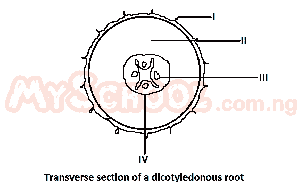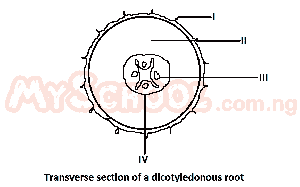Year :
1994
Title :
Biology
Exam :
JAMB Exam
Paper 1 | Objectives
1 - 10 of 50 Questions
| # | Question | Ans |
|---|---|---|
| 1. |
The membrane surrounding the vacuole in a plant cell is called the A. plasmalemma B. tonoplast C. nuclear membrane D. endoplasmic reticulum |
B |
| 2. |
The smallest living organism which share the characteristics of both living and non-living matter are A. bacteria B. fungi C. viruses D. protozoa |
C |
| 3. |
Green plants are distinguished from other living organisms by their ability to A. make use of water B. make use of oxygen C. respond to sunlight D. manufactured their own food |
D |
| 4. |
The soil swallowed by the earthworm to form the worm cast is grouped up in the A. clitellum B. protomium C. mouth D. gizzard |
D |
| 5. |
Which is the correct order in an evolutionary sequence for the following plants groups? A. Bacteria → ferns → algae → mosses → seed plants B. Bacteria → ferns → mosses → algae → seed plants C. Bacteria → algae → mosses → ferns → seed plants D. Bacteria → mosses → algae → ferns → seed plants |
C |
| 6. |
In Amoeba, osmoregulation is carried out by the A. pseudopodium B. food vacuole C. contractile vacuole D. nucleus |
C |
| 7. |
Which of the following combinations differentiates a bony fish from a cartilaginous fish? I. Presence of gills II. Absence of gill slits III. Possession of bony skeleton IV. Possession of laterally compressed body V. Possession of dorso-ventrally compressed body A. I, II and III B. I, III and IV C. II, III and IV D. II, III and V |
A |
| 8. |
Which is the most important adaptation of a bony fish life in water? A. The possession of a streamlined shape B. The presence of overlapping scales C. the covering of the body by thin film of slime D. The possession of a caudal fin |
A |
| 9. |
 Which of the labelled parts allows for efficient absorption of water and minerals? A. I B. II C. III D. IV Detailed Solutionthe part labelled I is called the ROOT HAIR... it is responsible for the absorption of minerals and water from the soil into the plant |
|
| 10. |
 Starch is usually stored in the part labelled A. I B. II C. III D. Iv |
D |
| 1. |
The membrane surrounding the vacuole in a plant cell is called the A. plasmalemma B. tonoplast C. nuclear membrane D. endoplasmic reticulum |
B |
| 2. |
The smallest living organism which share the characteristics of both living and non-living matter are A. bacteria B. fungi C. viruses D. protozoa |
C |
| 3. |
Green plants are distinguished from other living organisms by their ability to A. make use of water B. make use of oxygen C. respond to sunlight D. manufactured their own food |
D |
| 4. |
The soil swallowed by the earthworm to form the worm cast is grouped up in the A. clitellum B. protomium C. mouth D. gizzard |
D |
| 5. |
Which is the correct order in an evolutionary sequence for the following plants groups? A. Bacteria → ferns → algae → mosses → seed plants B. Bacteria → ferns → mosses → algae → seed plants C. Bacteria → algae → mosses → ferns → seed plants D. Bacteria → mosses → algae → ferns → seed plants |
C |
| 6. |
In Amoeba, osmoregulation is carried out by the A. pseudopodium B. food vacuole C. contractile vacuole D. nucleus |
C |
| 7. |
Which of the following combinations differentiates a bony fish from a cartilaginous fish? I. Presence of gills II. Absence of gill slits III. Possession of bony skeleton IV. Possession of laterally compressed body V. Possession of dorso-ventrally compressed body A. I, II and III B. I, III and IV C. II, III and IV D. II, III and V |
A |
| 8. |
Which is the most important adaptation of a bony fish life in water? A. The possession of a streamlined shape B. The presence of overlapping scales C. the covering of the body by thin film of slime D. The possession of a caudal fin |
A |
| 9. |
 Which of the labelled parts allows for efficient absorption of water and minerals? A. I B. II C. III D. IV Detailed Solutionthe part labelled I is called the ROOT HAIR... it is responsible for the absorption of minerals and water from the soil into the plant |
|
| 10. |
 Starch is usually stored in the part labelled A. I B. II C. III D. Iv |
D |